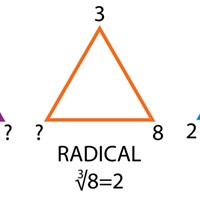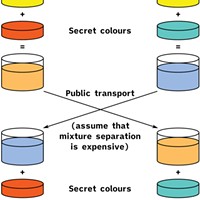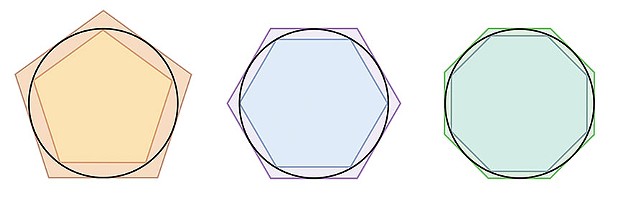[
{
"name": "Top Stories Video Pair",
"insertPoint": "7",
"component": "17087298",
"parentWrapperClass": "fdn-ads-inline-content-block",
"requiredCountToDisplay": "1"
}
]
The history of pi, or π (= 3.1416 ...) the ratio of the circumference to the diameter of a circle, is in some (very rough) way the history of mathematics, starting with the empirical age of math. Four thousand years ago, the only way to get a value for π was to physically measure it, that is, see how many times a diameter-length rope fits aound a circle's circumference. Three-and-a-bit? Close enough back then. Around 2000 BC, the ancient Egyptians were using a value of 256/81 (= 3.1604 ...) which they derived by assuming a circle with diameter 9 units has the same area as an 8 x 8 square. Which is better than exactly 3, as implied in the Old Testament (1 Kings 7:23).
Around 250 B.C., Archimedes of Syracuse first figured out how to calculate π using the geometry of regular polygons. He noted that the circumference of a circle lies between the perimeter lengths of its inscribed and circumscribed polygons (see diagram). With enormous effort, working with a 96-sided polygon (!), he showed that π lies between 3 10/71 and 3 1/7 (averaging to 3.1419 ...). Archimedes' method was still being used in Europe in the 1600s, with very little improvement in accuracy.
The next big step for mathematics — and for the calculation of π — probably originated in the south of India around 1400, with the discovery of the infinite series by Madhava of Sangamagrama. While infinity had scared off earlier mathematicians, Madhava (and 270 years later Scotsman James Gregory and German Gottfried von Leibniz) independently showed how to calculate π to any desired degree of accuracy by repeated application of a simple but infinite formula (π /4 = 1 - 1/3 + 1/5 - 1/7 ...). Sounds great, except figuring this out to half a million terms yields but five decimal places of accuracy.
In 1706, English astronomer John Machin improved on the Madhava-Gregory-Liebniz discovery: same idea, much better formula. I'm particularly partial to Machin's formula because it's incorporated into the 99-cent "PiAcademic" app. With it, I can compute (I use the word loosely!) the first 65,000 decimal digits of π in 18 seconds on my iPad.
Just 30 years ago (still paralleling the general evolution of mathematics) Machin-type π formulae gave way to iterative algorithms, in which the same function is applied to successive iterations: each iteration yields a closer approximation to π than the previous value. Common to all these schemes, from Archimedes onwards, is that knowing, say, the millionth digit of π, requires knowing the previous 999,999 digits. Makes sense, right?
Not to Quebecois mathematician Simon Plouffe, who figured out a "spigot formula" for π in 1995 (so called because it calculates a single isolated digit, like focusing on a single drip from a faucet rather than the entire flow). If you'd told previous π calculators that it was possible to calculate the ten trillionth digit of π knowing none of the previous digits, they'd have laughed at you.
But that's just what Plouffe showed the world of mathematics. It's 0, by the way.
Barry Evans ([email protected]) is teaching The History and Mystery of Pi at the Osher Lifelong Learning Institute on Oct. 31 and Nov. 7.
Speaking of...
-

The Log Connection
Jul 15, 2021 -

HSU Expanding Curriculum with Polytechnic Push
Jun 15, 2021 -

How to Trust Strangers
Mar 4, 2021 - More »
more from the author
-
A Brief History of Dildos
- Apr 11, 2024
-
Eclipse!
- Mar 28, 2024
-
The Little Drone that Could
- Mar 14, 2024
- More »
Latest in Field Notes
Readers also liked…
-
Trouble on the Line: The Reality Part 2
- Nov 3, 2022


































